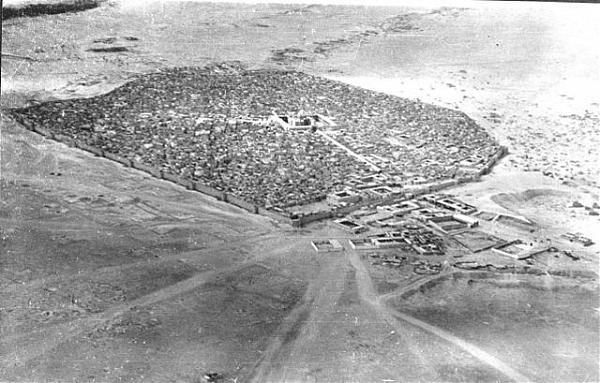
An Old Photograph of Najaf

A Rare Picture of Karbala
Dr.Mazhar
Naqvi
Like
Khwajasaras (Court Eunuchs), the role of Oudh (Awadh) Bequest in protecting the
holy shrines of Najaf and Karbala has also remained a subject of minimal study.
Except for the work of Meir Litvak, other historians have overlooked the great
role played by Oudh Bequest in not only protecting the shrine of Maula Ali and
Imam Hussain but also in preserving Imami seminaries after the plunder of Karbala
and Najaf between 1801 and 1810 AD. The bequest had originated from the third Oudh
loan extracted by East India Company from King Ghazi Uddin Haider for Nepal War in 1825.The
principal of 10 million was never to be repaid and a fixed yearly interest of 5
per cent was to be applied by the government of India in perpetuity to specific
purposes. The stipulated terms and conditions also included monthly allowances
for life of Rs.10000, Rs.2500, Rs.1100 and Rs.1000 to four women namely Mubarak
Mahal, Sultan Mariam Begum, Mumtaz Mahal and Sarfaraz Mahal. Each woman was
also given the power to bequeath one third of her allowance to any purpose she
desired. The remaining two thirds together with any portion of the one third if
bequeathed by any will from the beneficiaries was to be divided equally and
transferred to the Mujtahids residing in Najaf and Karbala for distribution to deserving persons ….. acquirement of religious
merit. The bequest became functional after the death of two widows of Ghazi
Uddin Haider in April and June 1849.
During
the first fifty years of its operation, the bequest channeled more than 6
million rupees with Murtuza Ansari being the first recipient in Najaf. The
amount offered much needed economic relief to thousands of Ulema families and
students who were living in abject poverty after the repeated raids carried out
by Wahabis in early 19th century. The Oudh Bequest also provided
means of sustenance to thousands of attendants at the shrines in the twin holy
cities. The 1854 distribution agreement reveals some 1000 members of established families of
Ulema ,one thousand Syeds and 600 students as beneficiaries at Karbala alone. It
also puts the figure of 1200 students as beneficiaries of the bequest in Najaf.
The economic significance of the bequest could be gauged from the words of
Murtuza Ansari “ we accepted the funds as many distinguished Ulema families had
been reduced to destitution and the need to enhance traditional Imami schooling
in view of Wahabi challenge demanded resources”.
It is also worth mentioning here that Ansari withdrew himself from distribution
after realizing that the British were using bequest as a ploy to buy influence
of Ulema to further their political interest in the region. It is not a hidden
secret that the British patronized Wahabis against the weal ottoman empire that
has been traditionally been maintaining the holy shrines. Hence, Ansari’s
action should be perceived as fully justified. But unfortunately his stand failed
to evoke desired response and the British continued their policy with ease. The
British appointed Syed Ali as Ansari’s successor.
Being
Imami by faith, the Oudh rulers, their ministers and courtiers always tried to
offer financial assistance to the institutions and people associated with them
at Najaf and Karbala. Before the bequest, it is recorded in history that
between 1786 and 1844 over Rs.1 million were sent to Karbala and Najaf from
Oudh for public welfare projects such as the construction of ‘Hindiya’ Canal
for brining water from Euphrates to the shrine cities.(Reference available on
request)
No comments:
Post a Comment